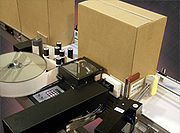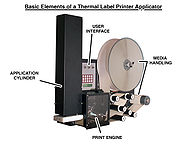
Label printer applicator
Encyclopedia


Robot
A robot is a mechanical or virtual intelligent agent that can perform tasks automatically or with guidance, typically by remote control. In practice a robot is usually an electro-mechanical machine that is guided by computer and electronic programming. Robots can be autonomous, semi-autonomous or...
s that automatically print and apply pressure sensitive label
Label
A label is a piece of paper, polymer, cloth, metal, or other material affixed to a container or article, on which is printed a legend, information concerning the product, addresses, etc. A label may also be printed directly on the container or article....
s to various products. Some types of labeling include shipping labeling, content labeling, graphic images, and labeling to comply with specific standards such as those of GS1
GS1
Founded in 1977, GS1 is an international not-for-profit association dedicated to the development and implementation of global standards and solutions to improve the efficiency and visibility of supply and demand chains globally and across multiple sectors...
and Universal Product Code
Universal Product Code
The Universal Product Code is a barcode symbology , that is widely used in North America, and in countries including the UK, Australia, and New Zealand for tracking trade items in stores. Its most common form, the UPC-A, consists of 12 numerical digits, which are uniquely assigned to each trade item...
U.P.C. A pressure sensitive label consists of a label substrate and adhesive. First developed in the late 1970s, today there are over 70 manufacturers of these types of machines worldwide.
Overview
Basic label printer applicators consist of three primary parts: a printer, or print engine, an applicator and a method to handle label and ribbons, referred to as media. Computing power also has the potential to increase the efficiency of label printer applicators.Print engine
The print engine can be taken from an industrial table top printer, it can be a specifically designed module that can be "bolted" onto an applicator or it can be a proprietary element constructed by the printer applicator manufacturer. A print engine’s primary function is to accept data from a computer and print the data onto a label for application. This printing can be accomplished using either the direct thermal method or the thermal transfer method. Both methods heat up very fine elements (up to 600 per inch) on a print head. Direct thermal burns the image onto the face of specially designed label stock. This is the preferred method for shipping labels and is also very popular in Europe. The thermal transfer process utilizes a ribbon coated with wax, resin, or a hybrid of the two. It is then heated and melted onto the surface of the label substrate. Thermal transfer is the most popular method in the United States. The printer knows what to print via data communication from an outside software package, much like common inkjet printers. The software delivers data formatted in a specific layout and the printer reads the format based on its own driver.Applicator
The applicator section delivers the label to the product. This can be accomplished by several methods. Typically application is achieved with a pneumatic or electric cylinder with a specially designed label pad. The cylinder will extend out and touch (tamp) the adhesive side of the label to a product. Variations of this method will extend the cylinder and then use air to blow the label to the product surface (tamp-blow]). Another popular method is a blow-on system that will use a burst of air to deliver the label from the pad to the product surface with out the use of a cylinder. Other methods can be used to wipe a label onto a surface, or even place two duplicate or unique labels on different sides of a product.Media
Media handling controls how the label stock is delivered to the print engine. It also performs the separation of the label from its backing and rewinds the waste label backing that remains after label application. This process can be difficult since consistent tension must be maintained for the label to peel off the liner and onto the applicator. Too much tension can cause the liner to break, which requires the machine to be rethreaded.Computing Power
Today, a fourth element to label printer applicators is emerging: computing power. Recently label printer applicators have been introduced which have the power to store large amounts of data. These machines can also control and harvest data from other input devices such as barcode scanners and weighing scales. These printer applicators can be programmed with special languages such as Fingerprint designed by IntermecIntermec
Intermec Inc. is a manufacturer and worldwide supplier of Automated identification and data capture equipment, including barcode scanners, barcode printers, mobile computers and RFID systems....
for Intermec print engines or MCL (Macro Command Language), a Datamax programming language. Now label printer applicators can communicate directly with an array of devices and hosts on the production line without the aid of a computer.
See also
- Thermal printerThermal printerA thermal printer produces a printed image by selectively heating coated thermochromic paper, or thermal paper as it is commonly known, when the paper passes over the thermal print head. The coating turns black in the areas where it is heated, producing an image...
- Thermal transfer printerThermal transfer printerA thermal transfer printer is a printer which prints on paper by melting a coating of ribbon so that it stays glued to the material on which the print is applied. It contrasts with direct thermal printing where no ribbon is present in the process...
- LabelLabelA label is a piece of paper, polymer, cloth, metal, or other material affixed to a container or article, on which is printed a legend, information concerning the product, addresses, etc. A label may also be printed directly on the container or article....
- Label printerLabel printerA label printer is a computer printer that prints on self-adhesive label material and/or card-stock . Label printers with built-in keyboards and displays, for stand-alone use , are often called label makers...
- Automatic label placementAutomatic label placementAutomatic label placement refers to the computer methods of placing labels automatically on a map or chart. This is related to the typographic design of such labels....
- Food labelling (disambiguation)
- Packaging and labeling
- Document AutomationDocument automationDocument automation is the design of systems and workflow that assist in the creation of electronic documents. These include logic based systems that use segments of pre-existing text and/or data to assemble a new document. This process is increasingly used within certain industries to assemble...

